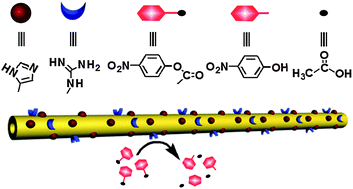Self-assembly of amphiphilic peptides into bio-functionalized nanotubes: a novel hydrolase model
Abstract
Herein, we report the construction of a novel hydrolase model via self-assembly of a synthetic amphiphilic short peptide (Fmoc-FFH-CONH2) into nanotubes. The peptide-based self-assembled nanotubes (PepNTs-His) with imidazolyl groups as the catalytic centers exhibit high catalytic activity for p-nitrophenyl acetate (PNPA) hydrolysis. By replacement of the histidine of Fmoc-FFH-CONH2 with arginine to produce a structurally similar peptide Fmoc-FFR-CONH2, guanidyl groups can be presented in the nanotubes through the co-assembly of these two molecules to stabilize the transition state of the hydrolytic reaction. Therefore significantly improved catalytic activity has been achieved by the reasonable distribution of three dominating catalytic factors: catalytic center, binding site and transition state stabilization to the co-assembled peptide nanotubes (PepNTs-His-Argmax). The resulting hydrolase model shows typical saturation kinetics behaviour to that of natural enzymes and the catalytic efficiency of a single catalytic center is 519-fold higher than that without catalysts. As for a nanotube with multi-catalytic centers, a remarkable catalytic efficiency could be achieved with the increase of building blocks. This model suggests that the well ordered and dynamic supramolecular structure is an attractive platform to develop new artificial enzymes to enhance the catalytic activity. Besides, this novel peptide-based material has excellent biocompatibility with human cells and is expected to be applied to organisms as a substitute for natural hydrolases.


 Please wait while we load your content...
Please wait while we load your content...